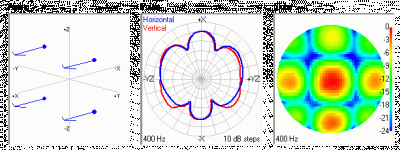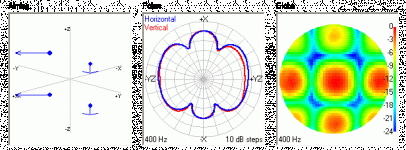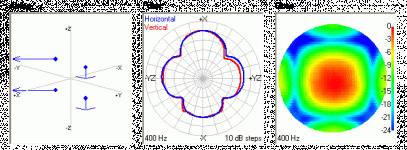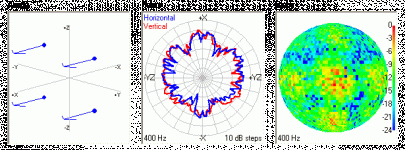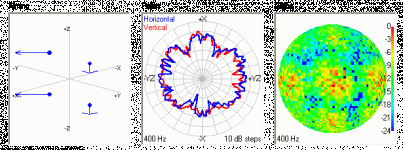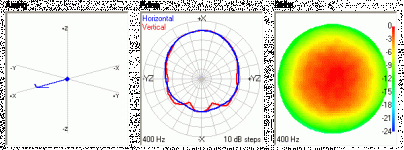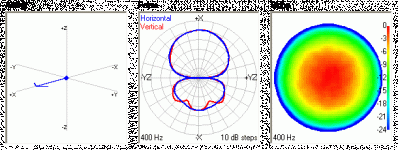Re: Quick Question
For one I remember posting some inwards bended baffle configurations for increasing pressure and shortening the width. Is that you remember? Or you look for an outwards bend to increase the horizontal dispersion as they near the top of their passband? I can simulate.
Lynn Olson said:
For Mige0, located at a nice place in the Alps. Or maybe it was Salas, in Greece. Sorry if I can't exactly remember the poster.
You mentioned some time ago that a baffle with a slight crease, or bend, in the middle would have a bit wider dispersion than a simple flat baffle. Assuming we're going to use 4 12 or 15-inch drivers in a square configuration, how much of a bend would be desirable - 15 degrees maybe? More? Less?
For one I remember posting some inwards bended baffle configurations for increasing pressure and shortening the width. Is that you remember? Or you look for an outwards bend to increase the horizontal dispersion as they near the top of their passband? I can simulate.
Good horn point Michael, and why ain't anyone investigating big and I do mean big waveguides for upper bass and midrange? Not everyone here must conform to high output but esthetically pleasing smaller cabinets.
Not talking about the 1" boutiques, but something like 12-15" UB and 6" - 8" mids. Compression drivers with horns forces the crossover point to 800hz to 1200 hz whereas a coned waveguide allows much lower mid crossover point. Seems as if one could have the best of both cones and horns. That would satisfy people that hate horns by calling them waveguides. Yes, I know the difference. I believe the Klangfilm followers in Europe have the answer for clean with balls even though are mostly straight horns. And that is BIG. Waveguides are not a dirty word for other than high mids. Earl Geddes' waveguides are too small for me, but he has helped me in my pursuit of larger ones. I believe, after studying his waveguides that straight sides whether flat or circular is not the answer and his throat recommendations should be followed. Coming straight from the cone without a transitional flare is nothing more than a conical horn speaker with Sd = St. Also, just a transition from round to square does not make it a good waveguide either.
Zene
Not talking about the 1" boutiques, but something like 12-15" UB and 6" - 8" mids. Compression drivers with horns forces the crossover point to 800hz to 1200 hz whereas a coned waveguide allows much lower mid crossover point. Seems as if one could have the best of both cones and horns. That would satisfy people that hate horns by calling them waveguides. Yes, I know the difference. I believe the Klangfilm followers in Europe have the answer for clean with balls even though are mostly straight horns. And that is BIG. Waveguides are not a dirty word for other than high mids. Earl Geddes' waveguides are too small for me, but he has helped me in my pursuit of larger ones. I believe, after studying his waveguides that straight sides whether flat or circular is not the answer and his throat recommendations should be followed. Coming straight from the cone without a transitional flare is nothing more than a conical horn speaker with Sd = St. Also, just a transition from round to square does not make it a good waveguide either.
Zene
Re: Quick Question
The sim confirms that an outwards bend increases the horizontal dispersion. Mic at 10 feet, 400Hz. Same thing happens @ 250Hz, Only the lobes are fatter. Best effect was with 45deg. Hey, that decreases baffle width substantially too.
See zero deg bend first.
Lynn Olson said:
Assuming we're going to use 4 12 or 15-inch drivers in a square configuration, how much of a bend would be desirable - 15 degrees maybe? More? Less?
The sim confirms that an outwards bend increases the horizontal dispersion. Mic at 10 feet, 400Hz. Same thing happens @ 250Hz, Only the lobes are fatter. Best effect was with 45deg. Hey, that decreases baffle width substantially too.
See zero deg bend first.
Attachments
panomaniac said:Whaaaaat? Can we believe what we're reading?

Lynn Olsen wants to use a 515 or a 416 for the bass? And a horn and compression driver for the mid - with an Altec style driver to boot? How can this be? We're talking West Coast sound, here. Horn colorations. Heavens!
Someone please alert the mods. Cal, Dave, Al, Sy? Can you check to see who has hacked Lynn's account?
.
.
.
.
.
.

seems that we are running in circles


john k... said:Salas,
Aren't those simulation just 4 directional, monopole sources positioned differently? How do they relate to open baffle?
You are right. Forgot that. Can they still indicate a wider front if in dipole but with different lobe shape?
Member
Joined 2003
Hi Salas,
I just don't think what you see with ArrayShow has any real relavance to OB systems since it doesn't consider the baffle. It is just looking at how arrays of the specified systems will sum.
What did you load as the device? What do you see when you change the device? The radiation pattern for each device is built into the device file.
I just don't think what you see with ArrayShow has any real relavance to OB systems since it doesn't consider the baffle. It is just looking at how arrays of the specified systems will sum.
What did you load as the device? What do you see when you change the device? The radiation pattern for each device is built into the device file.
hi Lynn
i am listening now with the Radian 950pb in a 49cm/19" tractrix horn, and above 8khz with the jbl 2405 slot tweeter. the JBL slot sounds a little too sharp to me, so i will replace it with a tweeter, i had in the past, but blowed it - i just bought another one : a Coral h100, which has 110db/wm, and sounds fabulous, and matches very well with midrange horns. There is someone in denmark, which bought the whole stock of the distributor , when Coral went bankrupt. He told me that it is better than the whole Fostex tweeter range, and has a performance similar to the Goto and Ale compresssion drivers, it sounds in the same league. I doubt a RAAL Ribbon will combine same good as as a high efficiency compression driver, with a midrange horn. If you intend to cross the mid horn as low as 350hz, than certainly a 12,5" hornmouth is too small, i would go for one with at least 20" . To load a 1.4" compression driver as low as 350 hz is not a good idea. Even a 2" exit driver, i would not cross lower than 600hz. I think a appropriate 6" cone driver in a midrange horn sounds fabulous. I heard the Avantgarde Duo at CES this year back in january, and their system impressed me , in my opinion it performed better than almost any other system at the show . Their midrange crosses as low as 170hz. Since their horn is much shorter, more like a waveguide, than a regular tractrix horn flare, there was no honk to be heard, it sounded very natural. So i think the B & W 6" in a 20" horn, at least, shorter than a regular tractrix curve , more like a waveguide, crossed at ~ 250hz, and your RAAL Ribbon in the treble, could be a great match. I am producing MDF tractrix horn commercially, and can design and model them of any horn flare and size, at very reasonable prices. This week my big turn lathe got ready, and i can make them up to 40 " diameter.
http://www.flickr.com/photos/12312992@N07/page1/
Angelo
i am listening now with the Radian 950pb in a 49cm/19" tractrix horn, and above 8khz with the jbl 2405 slot tweeter. the JBL slot sounds a little too sharp to me, so i will replace it with a tweeter, i had in the past, but blowed it - i just bought another one : a Coral h100, which has 110db/wm, and sounds fabulous, and matches very well with midrange horns. There is someone in denmark, which bought the whole stock of the distributor , when Coral went bankrupt. He told me that it is better than the whole Fostex tweeter range, and has a performance similar to the Goto and Ale compresssion drivers, it sounds in the same league. I doubt a RAAL Ribbon will combine same good as as a high efficiency compression driver, with a midrange horn. If you intend to cross the mid horn as low as 350hz, than certainly a 12,5" hornmouth is too small, i would go for one with at least 20" . To load a 1.4" compression driver as low as 350 hz is not a good idea. Even a 2" exit driver, i would not cross lower than 600hz. I think a appropriate 6" cone driver in a midrange horn sounds fabulous. I heard the Avantgarde Duo at CES this year back in january, and their system impressed me , in my opinion it performed better than almost any other system at the show . Their midrange crosses as low as 170hz. Since their horn is much shorter, more like a waveguide, than a regular tractrix horn flare, there was no honk to be heard, it sounded very natural. So i think the B & W 6" in a 20" horn, at least, shorter than a regular tractrix curve , more like a waveguide, crossed at ~ 250hz, and your RAAL Ribbon in the treble, could be a great match. I am producing MDF tractrix horn commercially, and can design and model them of any horn flare and size, at very reasonable prices. This week my big turn lathe got ready, and i can make them up to 40 " diameter.
http://www.flickr.com/photos/12312992@N07/page1/
Angelo
Paul W said:Salas,
I believe you may have provided a link before, but what software are you using for your simulations? Somehow I managed to misplace it in a recent move.
Thanks,
Paul
You must go to EV site and get ''Arrayshow''.
The gyrations may seem absurd, but I am converging in on what I want to do. I am not a pure subjectivist; all of my designs have to measure well in several domains in addition to meeting my subjective goals.
For the amplifiers, a key objective goal was the greatest possible intrinsic linearity in the forward path, particularly at low signal levels, and with very high rejection of induced noise from EMI and internal switching noise from the HV rectifiers (there are no low-voltage rectifiers). This dictated a certain design approach, and turning completely away from "Golden Age" tube amps of the Fifties. In fact, the Amity and Karna have nothing whatsoever to do with the amps of the Fifties - all of the tubes are different, all of the rectifiers, all of the PS caps (there are no coupling caps), and all of the circuitry. Not surprisingly, they sound different as well.
I want horn dynamics and OB clarity and absence of box coloration, but the method to get from here to there is open. I know I am extremely sensitive to horn coloration, and will go to some lengths to design it out - fortunately, MLSSA and SoundEasy are powerful tools to investigate the time domain, where the horn colorations lie. The Dr. Geddes technique is one avenue, but I am curious about others as well. Horn and waveguide design technique isn't at the beginning of the road (which was back in the Twenties), but it isn't at the end of the road either - so I believe in extensive measuring and audition to see where the theory diverges from the real world.
JLH (the Midwest horn designer alluded to in earlier posts) mentioned a preference for phenolic compression drivers for mid horns - this hit a sympathetic audience, since I've liked the sound of Klipsch horns - they are very crude sounding, but the absence of metallic "zing" is refreshing. Since I very much dislike the sound of metal-dome 1" tweeters - I've never once heard one I've liked in thirty years of loudspeaker design - I am kind of wary of metal diaphragms in compression drivers as well. I'm aware the Mylar surround of the Radians smooths out the resonant modes of the metal diaphragm, but in direct-radiators, plastic/metal composites can have the worst of both worlds - the dullness of plastic and not much attenuation of the ring modes of the metal.
I admit I'm influenced by what I've heard, and probably make inferences that are not entirely valid. I don't care for the sound of the Avant-Garde Duo or Trio at all (and I've heard them in systems much better than anything at the CES), especially the midrange, which sounds congested, murky yet still had all the usual horn colorations in full measure. This to me was the worst of all worlds - the colorations of a horn but without the sparkling speed, immediacy, and vivid tone colors of a really good large-format compression-driver horn system. Lowthers with front Tractrix and LeCleac'h horns are quite popular here, and they sound like BIG Lowthers with mucho dynamics (unlike the direct-radiator versions).
I am more convinced than ever that horns simply magnify the character of the driver that animates them. Put a Lowther back there, and you get a Lowther that sounds three feet wide and has another 10~15 dB of headroom. Put a metal diaphragm back there, and it sounds like a big version of the equivalent metal-dome tweeter - with much more headroom and much less distortion. But the sound of the material itself is always there - the horn or waveguide has no magic ability to "damp" internal resonances, nor would I expect it to - the Q of these resonances are extremely high, and they dissipate mechanical energy very slowly. The resonances dissipate slowly because of the large mismatch between the density of air and the density of the diaphragm - the horn increases the impedance of the air-load, true, but it doesn't reduce the Q and duration of the diaphragm resonances.
It is these mechanical resonances that overlay the music and add an inharmonic and annoying accompaniment to the listening experience, as well as degrading and compressing the spatial impression. If the resonances of the driver itself are only 10~15 feet away from the listener, that is certainly going to mask spatial impressions in the recording that are much further away.
This masking of spatial impression is probably less important for jazz recordings, where the recording space is much smaller and more comparable to the dimensions of the listening room. The relative absence of spatial impression is one reason why I can't use jazz recordings to evaluate a hifi system - I want the system to take me somewhere else, not put the musicians in the listening room. Many listeners and hifi enthusiasts like the sensation of "musicians in the room", but it sounds artificial to me. I expect the listening room to disappear, and to be transported magically back in time and space to the recording venue. Not many speakers do that.
It was reflecting on these problems that reluctantly made me think of a three-way system, which allows a narrower bandwidth for each group of drivers. I'm no expert on horns, but I discovered a lot of horn colorations are little more than trying to get too much bandwidth out of a bandwidth-limited device. Specifically, the ratio between the circumference of the mouth and the circumference of the throat is an indication of the horn's bandwidth - and most HF horns rely on diaphragm breakup and HF pattern narrowing to "extend" the bandwidth out to 15~20 kHz. This PA/moviesound tradition extends back to the Thirties, and has a lot of historical precedent.
The performance of the RAALs greatly exceeded my expectations - they don't sound like other ribbons much at all. Alexander's claim of solving the "dynamic" problem has been met - I heard more headroom than a compression-driver HF system, not something I expected at all. I suspect something bad is happening in the small passages of the phase-plug assembly at high frequencies, but cannot confirm it.
Again, I think the solution for a compression-driver and horn is to simply limit the bandwidth of the system and apply solutions appropriate for the wavelengths involved - and avoid using drivers with known (measurable) breakup problems as a technique to "extend" bandwidth. No FR smoothing, and confirmation that the time domain is well-behaved (decays 30 dB or more in less than 1 mSec). I have no doubt a compact, restricted-bandwidth HF horn/waveguide is capable of superb performance - but it might be pretty expensive and use exotic diaphragm materials.
The problem with OB's is nothing more than excess diaphragm excursion thanks to dipole cancellation below the baffle peak. This is easily solved not with EQ (which will make it worse), but increasing the radiating area to compensate. Compact + Dipole = Minimonitor Dynamics. You want small, you give up dynamics. Applies to other speakers as well, just not quite as much.
This leaves the midrange. I don't know what my preferred solution will be - I was about to write "optimum", but subjective preference is important here, since I'm pretty sure there are going to be tradeoffs between the time and nonlinear-distortion domains. The direct-radiator system is likely to have the best time performance and worst nonlinear-distortion performance, but I have no idea how the horn-loaded cone and compression-drivers will compare in the time and nonlinear-distortion domains. The ear reaches maximum audibility of of nonlinear distortion and resonant coloration in the 1~5 kHz region, and preferences are highly personal.
For the amplifiers, a key objective goal was the greatest possible intrinsic linearity in the forward path, particularly at low signal levels, and with very high rejection of induced noise from EMI and internal switching noise from the HV rectifiers (there are no low-voltage rectifiers). This dictated a certain design approach, and turning completely away from "Golden Age" tube amps of the Fifties. In fact, the Amity and Karna have nothing whatsoever to do with the amps of the Fifties - all of the tubes are different, all of the rectifiers, all of the PS caps (there are no coupling caps), and all of the circuitry. Not surprisingly, they sound different as well.
I want horn dynamics and OB clarity and absence of box coloration, but the method to get from here to there is open. I know I am extremely sensitive to horn coloration, and will go to some lengths to design it out - fortunately, MLSSA and SoundEasy are powerful tools to investigate the time domain, where the horn colorations lie. The Dr. Geddes technique is one avenue, but I am curious about others as well. Horn and waveguide design technique isn't at the beginning of the road (which was back in the Twenties), but it isn't at the end of the road either - so I believe in extensive measuring and audition to see where the theory diverges from the real world.
JLH (the Midwest horn designer alluded to in earlier posts) mentioned a preference for phenolic compression drivers for mid horns - this hit a sympathetic audience, since I've liked the sound of Klipsch horns - they are very crude sounding, but the absence of metallic "zing" is refreshing. Since I very much dislike the sound of metal-dome 1" tweeters - I've never once heard one I've liked in thirty years of loudspeaker design - I am kind of wary of metal diaphragms in compression drivers as well. I'm aware the Mylar surround of the Radians smooths out the resonant modes of the metal diaphragm, but in direct-radiators, plastic/metal composites can have the worst of both worlds - the dullness of plastic and not much attenuation of the ring modes of the metal.
I admit I'm influenced by what I've heard, and probably make inferences that are not entirely valid. I don't care for the sound of the Avant-Garde Duo or Trio at all (and I've heard them in systems much better than anything at the CES), especially the midrange, which sounds congested, murky yet still had all the usual horn colorations in full measure. This to me was the worst of all worlds - the colorations of a horn but without the sparkling speed, immediacy, and vivid tone colors of a really good large-format compression-driver horn system. Lowthers with front Tractrix and LeCleac'h horns are quite popular here, and they sound like BIG Lowthers with mucho dynamics (unlike the direct-radiator versions).
I am more convinced than ever that horns simply magnify the character of the driver that animates them. Put a Lowther back there, and you get a Lowther that sounds three feet wide and has another 10~15 dB of headroom. Put a metal diaphragm back there, and it sounds like a big version of the equivalent metal-dome tweeter - with much more headroom and much less distortion. But the sound of the material itself is always there - the horn or waveguide has no magic ability to "damp" internal resonances, nor would I expect it to - the Q of these resonances are extremely high, and they dissipate mechanical energy very slowly. The resonances dissipate slowly because of the large mismatch between the density of air and the density of the diaphragm - the horn increases the impedance of the air-load, true, but it doesn't reduce the Q and duration of the diaphragm resonances.
It is these mechanical resonances that overlay the music and add an inharmonic and annoying accompaniment to the listening experience, as well as degrading and compressing the spatial impression. If the resonances of the driver itself are only 10~15 feet away from the listener, that is certainly going to mask spatial impressions in the recording that are much further away.
This masking of spatial impression is probably less important for jazz recordings, where the recording space is much smaller and more comparable to the dimensions of the listening room. The relative absence of spatial impression is one reason why I can't use jazz recordings to evaluate a hifi system - I want the system to take me somewhere else, not put the musicians in the listening room. Many listeners and hifi enthusiasts like the sensation of "musicians in the room", but it sounds artificial to me. I expect the listening room to disappear, and to be transported magically back in time and space to the recording venue. Not many speakers do that.
It was reflecting on these problems that reluctantly made me think of a three-way system, which allows a narrower bandwidth for each group of drivers. I'm no expert on horns, but I discovered a lot of horn colorations are little more than trying to get too much bandwidth out of a bandwidth-limited device. Specifically, the ratio between the circumference of the mouth and the circumference of the throat is an indication of the horn's bandwidth - and most HF horns rely on diaphragm breakup and HF pattern narrowing to "extend" the bandwidth out to 15~20 kHz. This PA/moviesound tradition extends back to the Thirties, and has a lot of historical precedent.
The performance of the RAALs greatly exceeded my expectations - they don't sound like other ribbons much at all. Alexander's claim of solving the "dynamic" problem has been met - I heard more headroom than a compression-driver HF system, not something I expected at all. I suspect something bad is happening in the small passages of the phase-plug assembly at high frequencies, but cannot confirm it.
Again, I think the solution for a compression-driver and horn is to simply limit the bandwidth of the system and apply solutions appropriate for the wavelengths involved - and avoid using drivers with known (measurable) breakup problems as a technique to "extend" bandwidth. No FR smoothing, and confirmation that the time domain is well-behaved (decays 30 dB or more in less than 1 mSec). I have no doubt a compact, restricted-bandwidth HF horn/waveguide is capable of superb performance - but it might be pretty expensive and use exotic diaphragm materials.
The problem with OB's is nothing more than excess diaphragm excursion thanks to dipole cancellation below the baffle peak. This is easily solved not with EQ (which will make it worse), but increasing the radiating area to compensate. Compact + Dipole = Minimonitor Dynamics. You want small, you give up dynamics. Applies to other speakers as well, just not quite as much.
This leaves the midrange. I don't know what my preferred solution will be - I was about to write "optimum", but subjective preference is important here, since I'm pretty sure there are going to be tradeoffs between the time and nonlinear-distortion domains. The direct-radiator system is likely to have the best time performance and worst nonlinear-distortion performance, but I have no idea how the horn-loaded cone and compression-drivers will compare in the time and nonlinear-distortion domains. The ear reaches maximum audibility of of nonlinear distortion and resonant coloration in the 1~5 kHz region, and preferences are highly personal.
The performance of the RAALs greatly exceeded my expectations - they don't sound like other ribbons much at all. Alexander's claim of solving the "dynamic" problem has been met - I heard more headroom than a compression-driver HF system, not something I expected at all. I suspect something bad is happening in the small passages of the phase-plug assembly at high frequencies, but cannot confirm it.
[/B]
Can you qualify that? What horn speaker system do you have at home to compare to the ribbons? What midrange are you mating the ribbon with? I assume this was in your system - if not -

You will not find a non metallic large format compression driver made by anyone other than BMS, and they sound far worse than the Radians. Here's an idea for you- buy them both and measure them for music. Another Idea, have John build the horns so they can also be used (like my 360 flare horns) for six inch drivers, then you can compare all three.
Lynn Olson said:
The problem with OB's is nothing more than excess diaphragm excursion thanks to dipole cancellation below the baffle peak. This is easily solved not with EQ (which will make it worse), but increasing the radiating area to compensate. Compact + Dipole = Minimonitor Dynamics. You want small, you give up dynamics. Applies to other speakers as well, just not quite as much.
Hi Lynn. While we disagree on some fundamental issues most of those are more about design considerations and priorities. However, I believe this is one area where you will find that it's not as simple as that. Ultimately the system's nominal sensitivity will be determined by the sensitivity at the low frequency cut off and above that the response below the dipole peak will need to be attenuated by 6dB/octave if you do it passively, or boosted if you do it actively. If you do this at the line level I see little difference if this is done passively or actively other than the required gain of the preamp stage to produce a given SPL output and the quality of the active or passive circuits. But I don't see a way around the need for some type of 6db/octave eq because you can't compensate for the 6dB dipole roll off easily by adding additional drivers. You can, at best, shift the dipole roll off an octave lower each time you double up, assuming all the drivers have the same native response.
- Home
- Loudspeakers
- Multi-Way
- Beyond the Ariel
